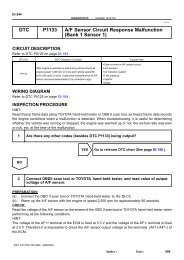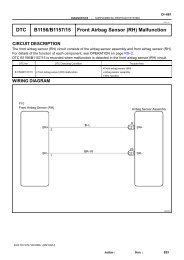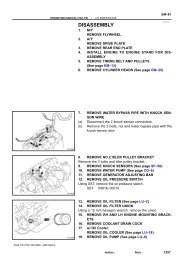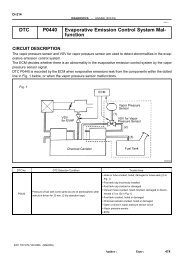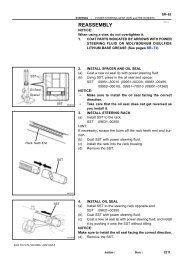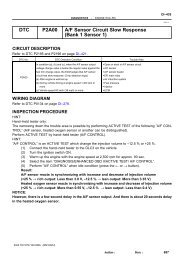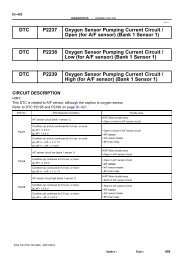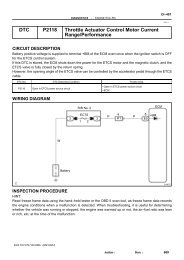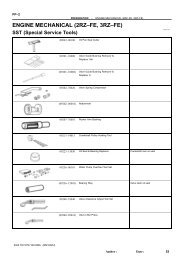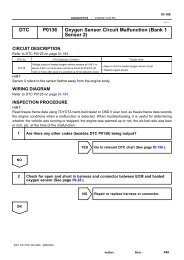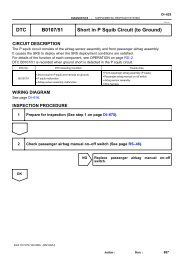DTC P2237 Oxygen Sensor Pumping Current Circuit / Open (for A/F ...
DTC P2237 Oxygen Sensor Pumping Current Circuit / Open (for A/F ...
DTC P2237 Oxygen Sensor Pumping Current Circuit / Open (for A/F ...
- No tags were found...
Create successful ePaper yourself
Turn your PDF publications into a flip-book with our unique Google optimized e-Paper software.
DI–194<br />
DIAGNOSTICS<br />
–<br />
ENGINE (2RZ–FE, 3RZ–FE)<br />
DIB2J–01<br />
<strong>DTC</strong> <strong>P2237</strong> <strong>Oxygen</strong> <strong>Sensor</strong> <strong>Pumping</strong> <strong>Current</strong> <strong>Circuit</strong> /<br />
<strong>Open</strong> (<strong>for</strong> A/F sensor) (Bank 1 <strong>Sensor</strong> 1)<br />
CIRCUIT DESCRIPTION<br />
Refer to <strong>DTC</strong> P2195 on page DI–185.<br />
HINT:<br />
This <strong>DTC</strong> is related to A/F sensor, although the caption is oxygen sensor.<br />
<strong>DTC</strong> No. <strong>DTC</strong> Detection Condition Trouble Area<br />
<strong>P2237</strong><br />
A/F sensor circuit (bank 1 sensor 1)<br />
Condition (a) and (b) continues <strong>for</strong> 5.0 sec. or more:<br />
(a) AF+ 0.5 V<br />
(b) AF+ > 4.5 V<br />
Condition (a) and (b) continues <strong>for</strong> 5.0 sec. or more:<br />
(a) AF+ – AF– 0.1 V<br />
(b) AF+ – AF– > 0.8 V<br />
HINT: Main trouble area<br />
<strong>Open</strong> or short in A/F sensor circuit<br />
<strong>Open</strong> or short in A/F sensor circuit<br />
A/F sensor<br />
A/F sensor heater<br />
EFI main relay<br />
HINT:<br />
After confirming <strong>DTC</strong> P2195, P2196, <strong>P2237</strong>, use the hand−held tester or OBD II scan tool to confirm<br />
an output voltage of the A/F sensor (AFS B1 S1/O2S B1 S1) from the ”DIAGNOSIS/ENHANCED OBD<br />
II/DATA LIST/ALL”.<br />
The A/F sensor’s output voltage and the short–term fuel value can be read using the OBD II scan tool<br />
or hand–held tester.<br />
The ECM controls the voltage of AF+ and AF– terminals of ECM to the fixed voltage. There<strong>for</strong>e, it is<br />
impossible to confirm the A/F sensor output voltage without OBD II scan tool or hand–held tester.<br />
OBD II scan tool (excluding hand–held tester) displays the one fifth of the A/F sensor output voltage<br />
which is displayed on the hand–held tester.<br />
WIRING DIAGRAM<br />
Refer to <strong>DTC</strong> P0134 on page DI–50.<br />
INSPECTION PROCEDURE<br />
HINT:<br />
Hand–held tester only:<br />
The narrowing down the trouble area is possible by per<strong>for</strong>ming ACTIVE TEST of the following ”A/F CON-<br />
TROL” (A/F sensor, heated oxygen sensor or another can be distinguished).<br />
Per<strong>for</strong>m ACTIVE TEST by hand–held tester (A/F CONTROL).<br />
HINT:<br />
”A/F CONTROL” is an ACTIVE TEST which change the injection volume to –12.5 % or +25 %.<br />
(1) Connect the hand–held tester to the DLC3 on the vehicle.<br />
(2) Turn the ignition switch ON.<br />
(3) Warm up the engine with the engine speed at 2,500 rpm <strong>for</strong> approx. 90 sec.<br />
(4) Select the item ”DIAGNOSIS/ENHANCED OBD II/ACTIVE TEST/ A/F CONTROL”.<br />
(5) Per<strong>for</strong>m ”A/F CONTROL” when idle condition (press the ← or → button).<br />
2003 TOYOTA TACOMA (RM1002U)<br />
Author:<br />
Date:<br />
456
DIAGNOSTICS<br />
–<br />
ENGINE (2RZ–FE, 3RZ–FE)<br />
DI–195<br />
Result:<br />
A/F sensor reacts in synchronizing with increase and decrease of injection volume<br />
(+25 % → rich output: Less than 3.0 V, –12.5 % → lean output: More than 3.35 V)<br />
Heated oxygen sensor reacts in synchronizing with increase and decrease of injection volume<br />
(+25 % → rich output: More than 0.55 V, –12.5 % → lean output: Less than 0.4 V)<br />
NOTICE:<br />
However, there is a few second delay in the A/F sensor output. And there is about 20 seconds delay<br />
in the heated oxygen sensor.<br />
Output voltage of A/F sensor<br />
(sensor 1)<br />
Output voltage of heated oxygen<br />
sensor (sensor 2)<br />
Mainly suspect trouble<br />
area<br />
Case 1<br />
Injection volume<br />
+25 %<br />
–12.5 %<br />
Output voltage<br />
More than 3.35 V<br />
Less than 3.0 V<br />
OK<br />
Injection volume<br />
+25 %<br />
–12.5 %<br />
Output voltage<br />
More than 0.55 V<br />
Less than 0.4 V<br />
OK<br />
<br />
Case 2<br />
Injection volume<br />
+25 %<br />
–12.5 %<br />
Output voltage<br />
No reaction<br />
NG<br />
Injection volume<br />
+25 %<br />
–12.5 %<br />
Output voltage<br />
More than 0.55 V<br />
Less than 0.4 V<br />
OK<br />
A/F sensor<br />
(A/F sensor, heater,<br />
A/F sensor circuit)<br />
Case 3<br />
Injection volume<br />
+25 %<br />
–12.5 %<br />
Output voltage<br />
More than 3.35 V<br />
Less than 3.0 V<br />
OK<br />
Injection volume<br />
+25 %<br />
–12.5 %<br />
Output voltage<br />
No reaction<br />
NG<br />
Heated oxygen sensor<br />
(heated oxygen sensor,<br />
heater, heated oxygen<br />
sensor circuit)<br />
Case 4<br />
Injection volume<br />
+25 %<br />
–12.5 %<br />
Output voltage<br />
No reaction<br />
NG<br />
Injection volume<br />
+25 %<br />
–12.5 %<br />
Output voltage<br />
No reaction<br />
NG<br />
Extremely rich or lean of<br />
the actual air–fuel ratio<br />
(Injector, fuel pressure,<br />
gas leakage in exhaust<br />
system, etc)<br />
The following procedure of A/F CONTROL enable that to check its output (show its graph indication) of A/F<br />
sensor and heated oxygen sensor.<br />
To display the graph indication. Select and push the ”YES or NO” button 2 data ”AFS B1S1 and O2S B1S2”<br />
or ”AFS B2S1 and O2S B2S2” and press button ”4” after selecting ”ACTIVE TEST/ A/F CONTROL/USER<br />
DATA”.<br />
HINT:<br />
Read frame freeze data using the hand–held tester or the OBD II scan tool, as freeze frame data records<br />
the engine conditions when a malfunction is detected. When troubleshooting, it is useful <strong>for</strong> determining<br />
whether the vehicle was running or stopped, the engine was warmed up or not, the air–fuel ratio was lean<br />
or rich, etc. at the time of the malfunction.<br />
2003 TOYOTA TACOMA (RM1002U)<br />
Author:<br />
Date:<br />
457
DI–196<br />
DIAGNOSTICS<br />
–<br />
ENGINE (2RZ–FE, 3RZ–FE)<br />
1 Check resistance of A/F sensor heater.<br />
Ohmmeter<br />
+B<br />
HT<br />
PREPARATION:<br />
Disconnect the sensor connector.<br />
CHECK:<br />
Using an ohmmeter, measure the resistance between terminals<br />
+B and HT.<br />
OK:<br />
B08732<br />
at 20°C (68°F)<br />
at 800°C (1,472°F)<br />
0.8 – 1.4 Ω<br />
1.8 – 3.2 Ω<br />
NG<br />
Replace A/F sensor.<br />
OK<br />
2 Check EFI main relay (Marking: EFI).<br />
2 5 3<br />
3<br />
5<br />
1 2<br />
PREPARATION:<br />
Remove the EFI main relay from RB No. 2.<br />
CHECK:<br />
Inspect the EFI main relay.<br />
OK:<br />
Condition Tester connection Specified condition<br />
1<br />
Constant<br />
t<br />
1 – 2 Continuity<br />
3 – 5 No continuity<br />
I05027<br />
Apply B+ between<br />
terminals 1 and 2.<br />
3 – 5 Continuity<br />
NG<br />
Replace EFI main relay.<br />
OK<br />
2003 TOYOTA TACOMA (RM1002U)<br />
Author:<br />
Date:<br />
458
DIAGNOSTICS<br />
–<br />
ENGINE (2RZ–FE, 3RZ–FE)<br />
DI–197<br />
3 Check <strong>for</strong> open and short in harness and connector between ECM and A/F sensor<br />
(See page IN–28).<br />
NG<br />
Repair or replace harness or connector.<br />
OK<br />
Replace A/F sensor.<br />
2003 TOYOTA TACOMA (RM1002U)<br />
Author:<br />
Date:<br />
459


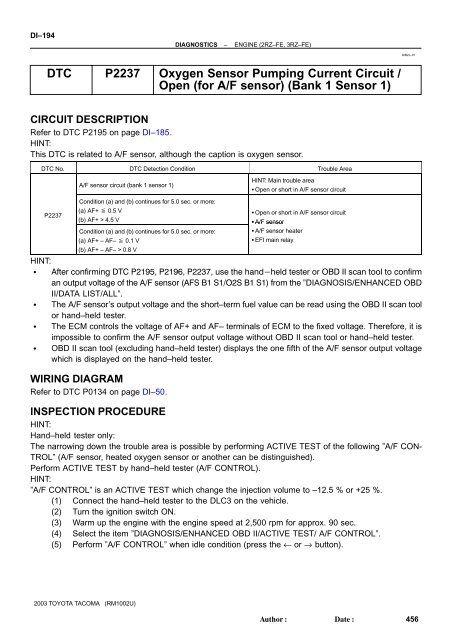
![F RELAY LOCATIONS [Engine Compartment] [Instrument Panel] 20](https://img.yumpu.com/53634281/1/184x260/f-relay-locations-engine-compartment-instrument-panel-20.jpg?quality=85)
